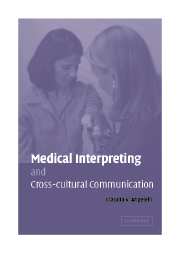Book contents
- Frontmatter
- Contents
- List of figures
- List of tables
- Acknowledgments
- List of abbreviations
- Prologue
- 1 Questioning invisibility
- 2 Communication in the medical encounter
- 3 A different set of lenses
- 4 California Hope: a public hospital in changing times
- 5 Putting it all together
- 6 Finding visibility
- 7 Interpreters' voices
- 8 Emerging metaphors and final words
- References
- Index
1 - Questioning invisibility
Published online by Cambridge University Press: 22 September 2009
- Frontmatter
- Contents
- List of figures
- List of tables
- Acknowledgments
- List of abbreviations
- Prologue
- 1 Questioning invisibility
- 2 Communication in the medical encounter
- 3 A different set of lenses
- 4 California Hope: a public hospital in changing times
- 5 Putting it all together
- 6 Finding visibility
- 7 Interpreters' voices
- 8 Emerging metaphors and final words
- References
- Index
Summary
Science would be superfluous if the outward appearance and the essence of things directly coincided.
Karl Marx, Capital, vol. 3, part VII, ch. 48, p. iiiCommunication between speakers who do not share a common language or culture has always been enabled by translation or interpreting. Interpreters are one component in a three-factor equation, which consists of more-dominant speakers, less-dominant speakers, and the interpreter. The role of interpreters in a bilingual encounter can take different forms. For example interpreters may help minority-language speakers explore possibilities, thereby channeling opportunities for them. This brokering may be achieved by being attentive to the social reality of the speakers. Alternatively, interpreters may focus on the message only, disregarding how it is socially constructed by each of the parties involved in the conversation. Another possibility is that interpreters may align with the speaker of the societal language, conveying information to the less-dominant speakers without helping them gain access to it. This last possibility positions interpreters as gatekeepers (Davidson 2001) rather than opportunity channels. Regardless of the role assumed by interpreters in the cross-linguistic encounter, they are vital for the communication of those who do not speak the majority language.
Language interpreters are often portrayed as invisible language facilitators. According to this perception of invisibility, interpreters are not considered to be parties to the conversation, but rather they are seen as language-switching operators in line with the conduit model of communication (Reddy 1979).
- Type
- Chapter
- Information
- Publisher: Cambridge University PressPrint publication year: 2004
- 1
- Cited by

